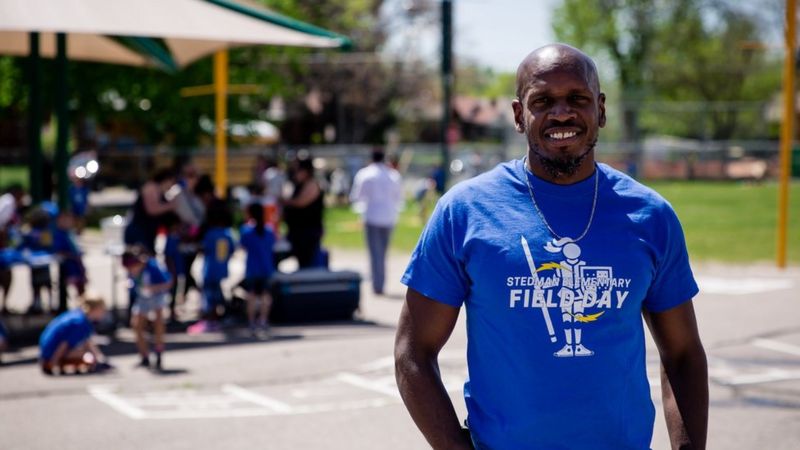
College Student Minorities on the Rise
With college student minorities on the rise, it is still only “a spit in the ocean” compared to what is needed to turn this problem around.
Can I be blunt? Is it o.k. with you if I speak frankly about a long-standing issue that has held back thousands of Americans?
What Is The Problem With College Student Minorities?
Let’s take a look at U.S. educators themselves as an example. Are you aware that only 2% of this critical group is made up of black males? You can imagine how easily they stand out at their conferences.
This fact was recently the subject of a report aired by WFLA/CNN in Denver, Colorado. The story about an incredibly determined 38-year-old black man spoke to the minds and hearts of thousands in their viewing area.
Let’s face it. This man could easily be the poster child for this tiny, yet significant, segment of educators.
Meet Mr. Michael Atkins

From Janitor to Principal, Minorities are on the Rise in Education
Photo thanks to WFLA/CNN in Denver, Colorado
Let me introduce you to Michael Atkins. Mr. Atkins is a new principal and has a very unique and inspiring story to tell. It would be challenging for you to find a better example of college minorities on the rise.
The story of his path from school custodian to the school principal is both remarkable and worthy of being told repeatedly.
You can see the original news report on this man’s success story here.
blob:https://assets.scrippsdigital.com/ec47d154-4dfa-4c46-86c8-ea29f6bb1765
We all need to be encouraged occasionally. Stories, like Atkins’, that share how someone overcame the odds are essential for all of us to hear.
Learning how people with a strong desire and determination to succeed do so is encouraging to others.
These stories provide evidence that the old saying, “where there is a will, there is a way” is still true today. The more we see others succeed, the more we believe that we, too, can succeed as well.
Michael Atkins’ success proves that your past does not define your future. Your degree of success is up to you and what you do to achieve it. Whether or not you succeed is up to you. It is your choice.
Where did his story begin?
Like many young, black men in his generation, Atkins grew up in a neighborhood where there was little opportunity. There were few if any, positive male role models in his life.
He only met his father once. His loving mother and grandmother did their best to raise this bright young boy. They made every effort to instill in him a strong desire to accomplish more in his life than what he saw around him. They also minimized the attitude of defeat so prevalent in their community.
The wisdom of his grandmother encouraged him to determine his own life rather than allowing others to do that for him. Atkins quoted her as saying, “Don’t let someone write your story, make sure you write your own story.” His grandmother added, “And if someone has something to do with your story, let them edit it, do not let them create it.”
How did he turn his life around?
That is precisely what he did, but not in the most direct way possible. He did not begin with Education as his first goal. He started his journey to becoming a high school principal from a very unique starting point.
Atkins began his arduous journey to becoming a school principal as a part-time, school custodian. He did his job to the best of his ability, as he had been taught to do.
Atkins was good at his job and took pride in it. Furthermore, he loved it, and those around him loved him.

Eventually, however, the desire to want more kicked in. The first step was to work his way into a full-time custodial position. Switching to a Full-Time job was probably the least challenging step.
It would have been easy to stop there, to rest on his laurels, so to speak. But, Atkins had not been brought up that way, remember?
He still wanted to “make more” of himself. Atkins viewed each step as a new challenge to be accepted and conquered. Taking one step at a time, he gradually worked his way “up the ladder.”
Atkins also recalls a chance meeting with a teacher who made a positive impression on him when he was seven years old. Re-connecting with this teacher proved to be a significant event in Atkins’ life.
This meeting provided a substantial boost in his upward path. This teacher helped Atkins obtain a para-professional position in a local school. Serving in this position initiated the real desire to pursue a career in education.

What is the value of his story to others?
The story of his choosing a career in education is inspirational. It warms the heart to see a young man overcome the overwhelming odds against him to reach his career goals.
You find yourself cheering for him at each step along the way and celebrating with him at each success. His ability to overcome hurdles helps you to believe you can do the same.
His story does more than warm your heart, though. It encourages you to do a bit of soul searching as well. Are there career goals that you never pursued yet still wish you had at least tried to achieve?
Virtually all of us have had a dream at some point or another. If we do not make an effort to make that dream come true, we risk it becoming a nightmare.
Getting to the age or physical condition where we can no longer make those dreams come true is a harsh realization. This is when your dreams turn into nightmares.
No one wants to reflect on their life, wishing that they had taken the action required to make that dream come true. It truly is better to have tried and failed than to never have tried at all.
Thankfully, there are many ways to increase the odds of being successful. Mr. Atkins is not the only man to have done so and you can do it, too.
Allow this story about Atkins’ success and become energized and inspired before taking the first steps toward turning your dream into a goal. Be sure to research the best way to achieve that goal.
If it requires a college degree, there are several articles on this website to guide you in the right direction. But first, take a look at the information below.
Atkins’ main message to current students today: “If I can make it, so can you.”
Although the numbers of minority students in college today are at an all-time high, the numbers are still quite low. Minorities are usually considered to be persons of Hispanic, Asian/Pacific Islander, and Black heritage.
Occasionally, you will see Native Americans included. They are often grouped with Pacific Islanders or with Alaskan Natives.
Statistics reported for 2016 claim that approximately 4% of college students self-identified as being of 2 or more races. The peak of minority college students enrolled in the fall of 2010 reported 21.0 million enrollees(source).
The enrollment for this same category of students predicted for the fall term of 2019 is approximately 5% less than the peak just mentioned.
The following incoming college student statistics (taken from government tables) have also been predicted for the 2019 fall term:
- 12.5 million students under age 25
- 7.4 million students >25 years old
- Females will outnumber males with 11.3 million female students (source) and 8.6 million male students enrolling
- 3.6 million Hispanic college students
- 2.6 million Black college students
- +1.3 million Asian and Pacific Islander college students
- 0.1 million American Indian/Alaska Native college students
- 0.7 million students of Two or more races
- 10.5 million White students (source)
-

college student minorities working together
How many college and university degrees are expected to be awarded for the academic year of 2019-2020?
- 989,000 associate’s degrees (source)
- 1,975,000 bachelor’s degrees
- 820,000 master’s degrees
- 184,000 doctor’s degrees
For Minority Students Going to College Today, There Are Important Choices
Both campus and online-based courses are open to you across the country. Many have additional support groups dedicated to helping you apply and to succeed once accepted.
There are scholarships available at virtually every college or university specifically for college student minorities. If you have a school counselor to help you through the process, take advantage of that opportunity.
Minority students are often the first in their family to ever attend college and have no one at home to guide them. Some colleges offer this kind of support. Check out their website to see what is available.
Professional organizations specific to minority groups often provide mentors and, sometimes, offer scholarships as well. So do other groups like Business and Professional Women Organizations.
The Association of American Indian Physicians offers guidance and other support for Native students interested in pursuing a career in medicine.
Their programs start at the high school level and go through medical school. https://www.aaip.org/about/
Many Minority Groups Offer Support
- The Hispanic Scholarship Fund was designed to help students of Hispanic heritage obtain a college degree.
- There are many groups dedicated to providing support to Black/African American students.
- Several Asian American organizations provide similar support to students.
- A quick Google search on either of these will give you quite a list to check out.
Have you decided to go to college?
Many students today are pursuing a college degree on their own terms. Meaning, they want to take classes when it best fits their schedule and from the school of their choice regardless of location.
Online college courses allow them to do just that. If this appeals to you, be sure to look over the other articles on this website. They will help you compare online colleges to a campus-based college.
You need to have a good understanding of the pros and cons of each before making such an important decision.
Good luck and remember the excellent advice of Atkins’ grandmother, “Don’t let someone (else) write your story!”
Your story has yet to be written. Choose wisely.
If You Want to Review the Numbers For College Student Minorities
NCES publishes a wide range of data. If you are interested in following the graduation rates, college costs, fields of study (or majors), number of degrees awarded, in annual publications, this is an excellent place to start.
You will also find a great resource in the Digest of Education Statistics.
Another excellent resource for information on college student minorities
U.S. Department of Education, National Center for Education Statistics. (2019). Digest of Education Statistics, 2017 (NCES 2018-070), Chapter 3.
If you are Native American and interested in Medicine, you may wish to check out this site. https://www.aaip.org/programs/student-programs/scholarships-internships-fellowships/
Photos thanks to WFLA/CNN in Denver, Colorado and Pixabay



Laurie Harmon
I found this very interesting. I loved the story of Mr. Atkins success moving up from janitor to principal. I love reading about true life stories of people overcoming hard times and making good things happen in their lives.
Susan Sloan
Laurie, thank you for your kind comments and support. Mr. Atkins is a remarkable man and a great role model for others.